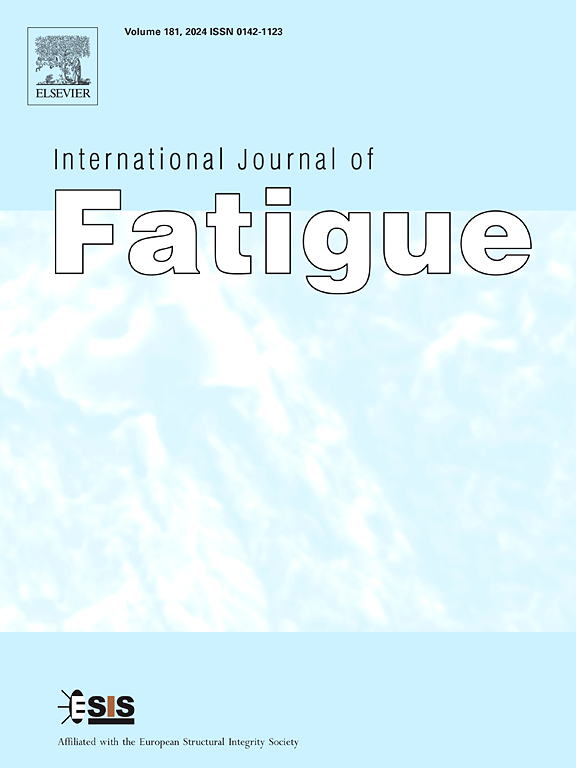Low-cycle fatigue damage mechanisms of in-situ TiB2 particles reinforced aluminum matrix composite
IF 6.8
2区 材料科学
Q1 ENGINEERING, MECHANICAL
引用次数: 0
Abstract
The large-strain controlled low-cycle fatigue (LCF) damage of particle-reinforced aluminum matrix composite was first studied, considering particle interfaces and slip bands. It is found that the LCF damage behavior of the composite was dominated by the mutual effects between soft matrix and hard particles. Local deformation mainly concentrated at the T-Al20Cu2Mn3 dispersoids with larger aspect ratio, secondary phases and aligned TiB2 particles due to local plastic incompatibility and stress concentration. These features are the main source of LCF damage and exhibit are strain amplitude dependence. At low strain amplitudes (< 0.8 %), the cyclic deformation is dominated by elastic strain. The crack initiation is greatly related to secondary phase cracking. At high strain amplitudes (≥ 0.8 %), the slip bands are prevalent in the matrix and the damage behavior of the composite is controlled by cyclic plastic deformation. The strengthening layer is generally formed around TiB2 particles due to the formation of strain gradient at TiB2-Al interface, which increase the cracking resistance of TiB2-Al interface and depend on strain amplitudes. The correlative cyclic damage models were established based on microstructure evolution.
原位TiB2颗粒增强铝基复合材料的低周疲劳损伤机理
首次研究了考虑颗粒界面和滑移带的颗粒增强铝基复合材料的大应变控制低周疲劳损伤。研究发现,复合材料的LCF损伤行为主要受软基体和硬颗粒的相互影响。由于局部塑性不相容和应力集中,局部变形主要集中在展宽比较大的T-Al20Cu2Mn3分散体、二次相和排列的TiB2颗粒上。这些特征是LCF损伤的主要来源,并表现出应变幅值依赖性。在低应变幅值(<;0.8%),循环变形以弹性应变为主。裂纹的萌生与二次相开裂有很大关系。在高应变幅值(≥0.8%)时,基体中普遍存在滑移带,复合材料的损伤行为受循环塑性变形控制。由于TiB2- al界面应变梯度的形成,强化层一般在TiB2颗粒周围形成,该强化层的形成取决于应变幅值,从而提高了TiB2- al界面的抗裂能力。基于微观结构演化建立了相关的循环损伤模型。
本文章由计算机程序翻译,如有差异,请以英文原文为准。
求助全文
约1分钟内获得全文
求助全文
来源期刊

International Journal of Fatigue
工程技术-材料科学:综合
CiteScore
10.70
自引率
21.70%
发文量
619
审稿时长
58 days
期刊介绍:
Typical subjects discussed in International Journal of Fatigue address:
Novel fatigue testing and characterization methods (new kinds of fatigue tests, critical evaluation of existing methods, in situ measurement of fatigue degradation, non-contact field measurements)
Multiaxial fatigue and complex loading effects of materials and structures, exploring state-of-the-art concepts in degradation under cyclic loading
Fatigue in the very high cycle regime, including failure mode transitions from surface to subsurface, effects of surface treatment, processing, and loading conditions
Modeling (including degradation processes and related driving forces, multiscale/multi-resolution methods, computational hierarchical and concurrent methods for coupled component and material responses, novel methods for notch root analysis, fracture mechanics, damage mechanics, crack growth kinetics, life prediction and durability, and prediction of stochastic fatigue behavior reflecting microstructure and service conditions)
Models for early stages of fatigue crack formation and growth that explicitly consider microstructure and relevant materials science aspects
Understanding the influence or manufacturing and processing route on fatigue degradation, and embedding this understanding in more predictive schemes for mitigation and design against fatigue
Prognosis and damage state awareness (including sensors, monitoring, methodology, interactive control, accelerated methods, data interpretation)
Applications of technologies associated with fatigue and their implications for structural integrity and reliability. This includes issues related to design, operation and maintenance, i.e., life cycle engineering
Smart materials and structures that can sense and mitigate fatigue degradation
Fatigue of devices and structures at small scales, including effects of process route and surfaces/interfaces.
 求助内容:
求助内容: 应助结果提醒方式:
应助结果提醒方式:


